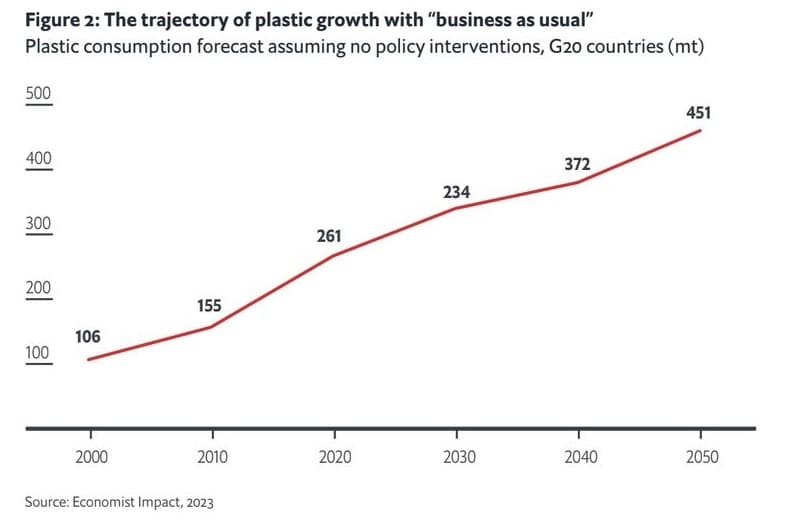Insatiable appetite for plastics 01-03-2023 - Arhive
Insatiable appetite for plastics
-Curbing our insatiable appetite for plastics – yes, but how?
New study: ’Bold and comprehensive set of policies’ alone can stem plastic waste crisis
According to the findings of a new study from Back to Blue, an initiative of Economist Impact and The Nippon Foundation, the efforts currently being explored by the UN to halt the growth in plastic consumption and to ‘bend the curve’, will not achieve their goal by 2050.
Entitled Peak Plastics: Bending the consumption curve, the report confirms that an ‘urgent, global effort is needed to stop the flood of plastic pollution at its source’, as David Azoulay, of the Center for International Environmental Law, pointed out.
The entire lifecycle of plastics […] must be addressed by the future, legally binding UN treaty to end plastic pollution, he said. Insatiable appetite for plastics
Much ground remains to be covered before such a treaty has been conceived, let alone implemented.
In March last year, representatives from 175 countries endorsed a resolution on plastic pollution at the United Nations Environment Assembly, agreeing to develop a legally binding global instrument to end plastic pollution: the UN Treaty on Plastic Pollution.
The initial negotiating session was held in Uruguay at the end of November, and another four will follow, with the treaty expected to be in place by the end of 2024.
The negotiators are therefore considering a range of possible measures to include in the treaty, aimed at what this study refers to as ‘reaching peak plastic consumption’, i.e., the point and volume at which global plastic consumption stops growing and begins to drop.
“The urgency to reach peak plastic waste—and also peak production of disposable plastics—is crucial for preserving our planet and safeguarding our well-being,” said Perinaz Bhada Tata, World Bank. Insatiable appetite for plastics
In the present study, which builds on work previously done by numerous prominent authorities, including OECD, the World Bank, SYSTEMIQ, CSIR, and WWF, the potential impact of three of the policy approaches being considered by United Nations plastic treaty negotiators has been forensically modelled for the first time.
These three, believed to have greater potential than others to arrive at the point of peak consumption in the foreseeable future, are a phased ban on single-use plastic products; a mandatory extended producer responsibility regime imposed on brands and retailers introducing packaging on the market; and a tax on the production of virgin resin manufactured from petrochemical feedstock. Insatiable appetite for plastics
The model tested whether any of these, alone or together, could reach peak plastic consumption before 2050.
Back to Blue’s modelling uses a quantitative forecasting methodology to predict at what point each country will peak in its plastic consumption. The seven categories of polymers used in the model account for 80% of all plastic production.
Failure to agree on any policy interventions will result in plastics consumption across G20 countries hitting 451 million tonnes by 2050, nearly twice the 2019 level of 261 million tonnes, the study found.
Dismayingly, it also revealed that the three policy levers examined were insufficient to halt the inexorable rise in plastic consumption, either singly or combined.
Admittedly, a combination of all three scenarios will somewhat slow the rate at which plastic consumption will rise – growth of 1.25 times the 2019 figure instead of 1.73 – but still nowhere near the goal of bending the consumption growth curve downward by the middle of the century. Insatiable appetite for plastics
The study indicated that a ban on unnecessary single-use plastic products (SUPP) yields the greatest impact, doing more than either an EPR mandate or a plastics tax to restrain consumption growth.
Modelling showed that, with a ban in place, plastic consumption would be 1.48 times higher in 2050 compared with the 2019 baseline.
Extended Producer Responsibility (EPR) schemes were seen to have only a minimal effect on the consumption of single-use plastic products, but, as the authors point out, are still a vital part of the solution. Insatiable appetite for plastics
EPR will improve waste collection and increase recycling rates, thus averting plastic leakage into the environment.
However, EPR schemes will have little impact on the growth in plastic consumption, which is projected to rise to 1.66 times the 2019 baseline by the year 2050: fractionally lower than the 1.73 forecast in the business-as-usual scenario.
The model also yielded a limited impact of a plastic tax on consumption growth: this was projected to rise by 1.57 times by 2050.
A bigger impact could be achieved with tax rates higher than the existing benchmarks, perhaps combined with more aggressive targets for recycled content as well as a cap on virgin plastic production. Insatiable appetite for plastics
The report concludes that if plastic consumption growth is to be reversed by mid-century, the plastics treaty will need to ‘stipulate more stringent measures and conditions’ than factored into the present model.
As Charles Goddard, editorial director of Economist Impact, said: “Negotiators of the UN plastics treaty must maintain the highest levels of ambition possible when entering the next round of negotiations, and industry needs to play a constructive, not obstructive, role in reaching a deal. Insatiable appetite for plastics
So far, commitments by industry, retailers and brands to reduce plastic waste are short on detail and have failed to materialise.
We have to slow the soaring production of single-use plastic. Only a bold suite of legally-binding policies will result in plastic consumption peaking by mid-century.”

Insatiable appetite for plastics
